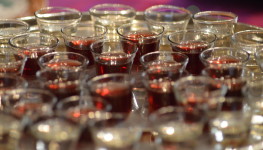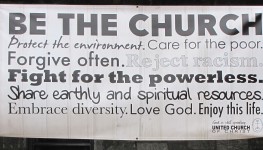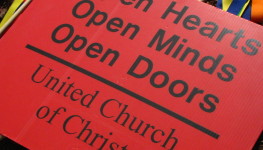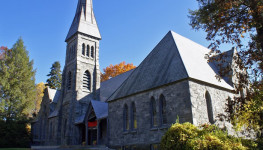“Creation Re-Imagined”
Genesis 9:8-17
Psalm 25:1-10
Long before some four million residents of my home state of Texas lost power, heat, water, and more last week, I had reflected on the scripture readings for the First Sunday in Lent and decided to focus on God’s post-flood covenant with all creatures and the earth itself.
Back then, I could not have imagined my mom spending days in bed, shivering under the covers in her unheated house. I could never have imagined my dad and stepmother needing to melt snow—and having more than enough of the white stuff on hand in the Texas Hill Country—to flush their toilets.
Back then, I just thought that the story of God’s covenant with all creation was a moving and powerful testimony—not only to the ever-loving, all-inclusive heart of God, but also to God’s timeless call to us to reimagine creation and our relationship to it.
Which is to say: I wish today’s worship theme were not so heartbreakingly timely. While I’m at it, I wish the human spiritual journey were a long, smooth, happy ride to greater awareness, deepening compassion, and more complete union with God, rather than the more common two-steps-forward, one-step-back, fits-and-starts pilgrimage punctuated by wrong turns and occasional catastrophe.
But thank God that it is never too late to get back on track, that we are never too far gone to come home, that somehow—by faith, perseverance, and more love and grace than we can comprehend—we can be born again, healed and transformed again and again and again into something closer to who we were meant to be.
It is a process, this learning to live and love in God. We are works in progress, created in love for love—regularly delivered from our own woundedness and wandering, routinely absolved of our worst mistakes, given an infinite number of chances to clean up our messes and begin again.
Thanks be to God that we have been made in the divine image, because this means not only that we were made for love but also that we were made to learn and grow in Spirit and in truth, to be healed and transformed by a love that sometimes asks of us more than we think we have.
We know this because this is what our Creator God does—she love and suffers for it, she acts out and repents of it, and then recommits herself to an even more unreserved, unrelenting, and unconditional love.
As you may recall, the God who created everything from nothing and called it all good was all but undone by the human capacity for cruelty and violence.
The Lord saw that the wickedness of humankind was great in the earth, the story says, and that every inclination of the thoughts of their hearts was only evil continually. And the Lord was sorry that he had made humankind on the earth, and it grieved him to his heart. So the Lord said, “I will blot out from the earth the human beings I have created—people together with animals and creeping things and birds of the air, for I am sorry that I have made them.
Enter Noah and his family, an ark, animals two by two, and lots and lots of rain. Enter drowning and death and destruction.
But what was intended as a clean start, a divine reset, Creation 2.0, instead became a source of divine regret.
Now, as you may know, great flood stories were a common motif of the ancient world, a method for both making sense of natural disasters and inspiring obedience to an angry deity.
But this is not the story the Hebrew exiles tell. This is not the kind of deity the Hebrew exiles, for whom Jerusalem and home might as well have been obliterated by a flood, believe they have. They see in their flood story not only a new creation but also a changed God.
The God of heaven and earth is adaptable; upon learning that violence and punishment don’t heal the hurt in the divine heart, God changes course.
The God of Noah and his family is faithful, choosing again to love her all her creation without reserve.
The God of you and me is all in; she just can’t quit us.
And so God establishes a covenant with all creation—humankind, every living creature, and the earth itself—to never again send a flood to destroy the earth. Now, a good lawyer might have suggested to God that he make three separate covenants: one with humankind, one with living creatures, and one with the earth. A good lawyer might have pointed out that a contract is a two-way street, and suggested spelling out what God wanted in return for her promise and protection.
But there are no limits to God’s love and nothing anyone has to do to earn it, so God’s covenant is unconditional and one-sided. And because God created all things, God knows all things are connected, all things are kin, and so there is need for only one covenant for them all, and one sign to seal the deal: a bow in the sky.
We think we know this story. We think we understand it.
But what if we let this story reshape our understanding of creation? What if we let God’s love lead us to reimagine our relationship to creation—not as something separate from us, but as kin to us; not as something to control, but as something to love and nurture?
“The bloodline of God is connected to everything,” says the Native American and Christian writer Kaitlin B. Curtice. “Shells on the ocean shore, the mushrooms growing in the forest, the trees stretching to the clouds, the tiniest speck of snow in the winter, and our dust-to-dustness—we are all connected and tethered to this sacred gift of creation.”
Indigenous peoples have long known this connection. But for many of us—descendants of conquerors, interlopers, and resource miners—to see other creatures and all creation as our kin requires reimagination. It is hard work, but it is bearing fruit.
In New Zealand, the native Whanganui Maoris have finally succeeded in getting the government to recognize the long-abused Whanganui River—now known by its original name, Te Awa Tupua—as their ancestor and source of spiritual power, a living being with legal status.
In Ecuador, the national constitution now declares nature’s inalienable rights to exist and flourish and give life—rights that limit so-called development.
The people of Toledo, Ohio, have also begun to reimagine their relationship to their environment. City voters have granted Lake Erie the same legal rights as people.
Most Native American cultures have long had respectful relationships with animals and all living things. Before they cut down a tree, for example, or harvest wild berries, they will ask the plants’ permission and then, if that permission is granted, give thanks and take steps to replenish what was taken.
To imagine, and then live into, something new and different is an an act of faith and hope. It is also the call of the Gospel and the prayer of Jesus we have made our own: Thy kingdom come.
Last week’s deadly deep-freeze in Texas is a harsh reminder of an inconvenient but undeniable truth: That we are not separate from our environment; rather, everything is connected to everything else. How we live and what we do has impacted our environment, and the changing climate will continue to impact us.
What does it mean to reimagine our relationship to creation? What would that look like? What would it mean to reimagine the relationships between humankind and the earth, between industry and humanity, between government and the governed?
These are not hypothetical questions.
Consider, for example, how the situation for million of Texans might have been different last week if power generation and distribution were a sacred trust rather than a profit-making commodity. Consider how the situation might have been different if the state of Texas had maintained its relationship—kinship, if you will—with the rest of the country instead of going it alone. Consider how the aftermath of the disaster might have been different if elected leaders had actually known themselves to be servants of the people.
Consider, for example, how our own lives might be enriched if we were to imagine the earth, the air, the water, and all creatures as God’s beloved “great chain of being.”
If the Maker of Heaven and Earth can repent, surely we can change our ways. If the Divine Lover can bind herself to all creation without condition and at great cost, surely we can learn to love creation as our kin.
All the paths of God are steadfast love and faithfulness. In this Lenten season, as we walk those paths with Jesus, may we reimagine our place in this beautiful and broken world.




